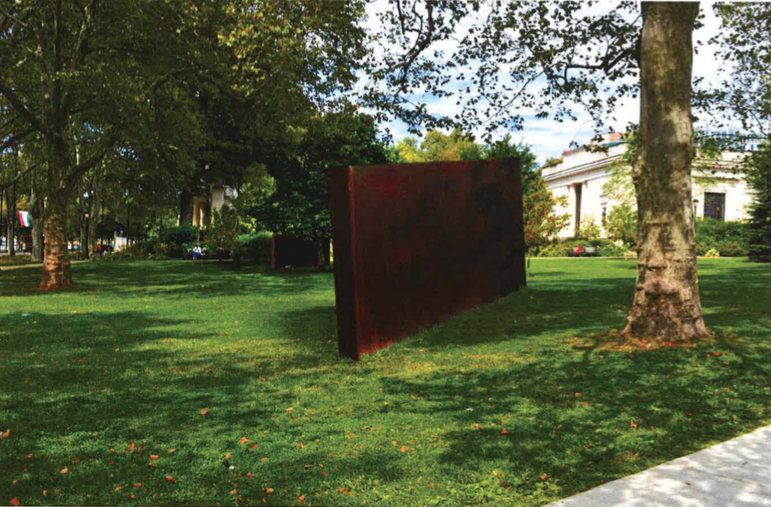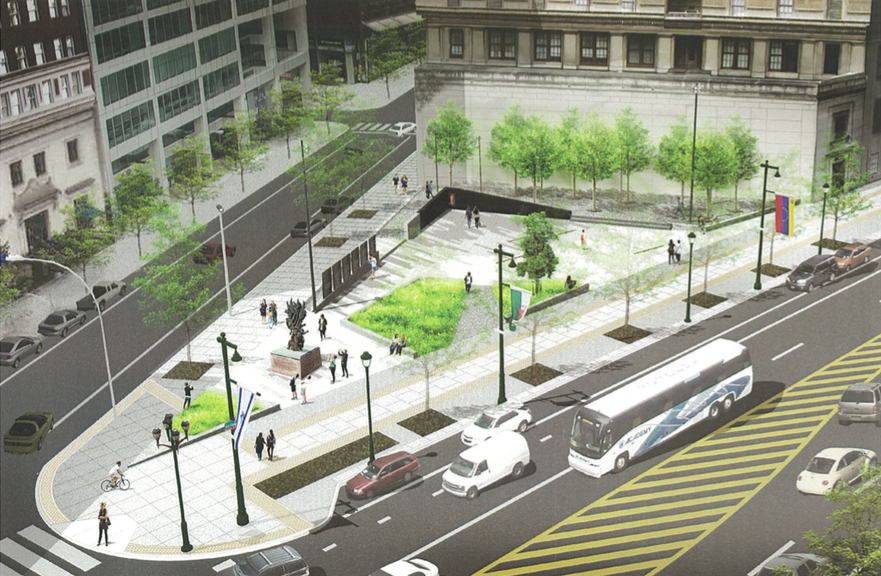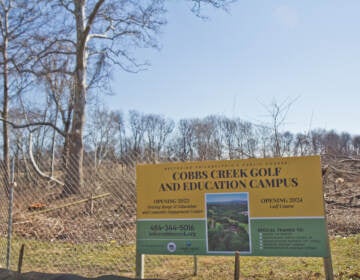Art Commission approves Richard Serra sculpture for Parkway, redesign ahead for Holocaust Memorial

Wednesday’s Art Commission meeting opened with two major upgrades to established sites on the Benjamin Franklin Parkway.
The director of the Philadelphia Museum of Art, Timothy Rub, laid out a proposal for an installation by famed sculptor Richard Serra near the Rodin Museum. At an indeterminate point in the near future, two enormous Corten steel plates will be installed on the grounds to the east of the small sculpture museum. The first, Plate A, is 10 feet 6 inches high, 20 feet long, and eight inches wide. Plate B will be placed to its right and punches in at nine feet high, 20 feet long, and eight inches thick.
The Serra installation is a result of a massive new donation by art collectors Keith and Kathy Sachs, who have dedicated most of their holdings to the Philadelphia Museum of Art. This includes the Serra sculptures, which they commissioned in 1988.
The city owns the Rodin Museum, although it is administered by the Philadelphia Museum of Art (which the city does not own in full although it does own the building). Upon inspecting the available land, Serra himself decided that the grounds of the former would be the best place for the installation because “Plate B rides the landscape,” as Rub explained, and the ground there is inclined.
Rub said he’d met with a number of stakeholder groups, including the Historical Commission and Philadelphia Parks and Recreation, and that security and lighting concerns were raised.
“The most vexing question is if gets scratched or graffitied,” said Rub, emphasizing the importance of the setting Serra selected for the work. “In his opinion the Rodin Museum is the perfect site for this.”
Art Commission chair Alan Greenberger dismissed the idea that the sculptures could provide a space for muggers to operate. There are plenty of places to lurk in the urban landscape, he argued, but an art installation next to the very well-lit and highly traveled Parkway isn’t likely to present a uniquely tempting hideout.
But Rub correctly predicted that the graffiti question would prove a sticking point. Joe Laragione, a painter on the board, grew so concerned about the possibility that he eventually voted to not approve the project.
“It’s going to be a target for graffiti artists, within weeks,” said Laragione. “I guarantee they are going to see this as a blank canvas. “If you try to cover it with polyurethane or something to protect it from graffiti it would defeat the purpose. Getting it [paint] off and maintaining that beautiful surface will be impossible.”
Rub disagreed, noting that since the 2012-2013 renovations to the Rodin Museum and its sculpture garden—a period when more Rodin sculptures were reinstalled outside—a grand total of zero instances of vandalism have occurred.
The rest of the Art Commission seemed to agree, with everyone but Laragione voting to approve the project.
Just down the Parkway toward City Hall is the Philadelphia Holocaust Memorial, which currently consists of a lone stature, Nathan Rapoport’s “Monument to Six Million Jewish Martyrs.” The wedge of park behind it does not accentuate the artwork and the memorial is easily overlooked (despite being the first American monument to the great tragedy). The new design would expand the park to include six pillars to symbolize the six million murdered, and a tree grown from a cutting in the Theresienstadt concentration camp, an imprint of train tracks, and a wall situated to the west of the pillars that will contain an “eternal flame.”
After hearing the commission’s concerns about the new design this summer, the team behind the memorial—a partnership between The Remembrance Foundation, design firm WRT, Post Brothers, and the Center City District–have made a few changes in accordance with the body’s suggestions. The grove of trees at the back of the park, meant to symbolize the forests that sheltered the partisan resistance to the Nazis, have been thinned out so as to not provide a space for “unscrupulous acts.” More grass was added to a few corners of the park as well. Post Brothers president Matthew Pestronk wasn’t yet prepared to share the text of what would actually be on the six pillars, only saying that one side would be a message celebrating the rights and protections of the United States Constitution and on the other a recounting of the horrors of the Holocaust.
“Visitors will understand that so long as the United States remains faithful to the Constitution, a Holocaust could not occur here,” read one slide in the presentation.
The presentation also clarified that the eternal flame that will flicker at the monument will be a digital projection in a hollow of the wall. It will be played day and night throughout the year.
A resident of the Phoenix Apartment building, Rick Morris, stood up to ask how the park’s designers are accounting for the throngs of pedestrian traffic that will flow through the park every day.
“It’s part of the city so they’ll walk through and maybe they’ll notice it,” said Pestronk. “In an ideal world, there would be far fewer entry points, but it’s public property at a major intersection so it’s going to be a balance between contemplative, utilitarian, and inviting.”
In the end, Chairman Greenberger asked for conditional approval of the project hinging upon the commission’s viewing of the text. This would allow Pestronk and company to get started, but still allow the Art Commission to veto the wording if they were dissatisfied the text on the pillars.
Greenberger insisted that he didn’t think this outcome likely, but that he didn’t want to shrink the body’s duty to the city without seeing the actual wording first.
“I don’t want us wordsmithing this thing but I think we need to feel the tone,” he said. “Probably won’t go wrong at all, but at the same time we have to guard against something being provocative in the wrong spirit. I don’t think that’ll happen but I don’t want to find out it happened and then have the commission criticized.”
The conditional approval of the project received a unanimous vote of approval.
WHYY is your source for fact-based, in-depth journalism and information. As a nonprofit organization, we rely on financial support from readers like you. Please give today.






